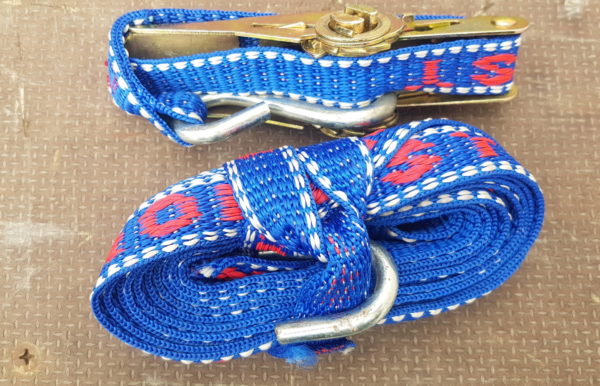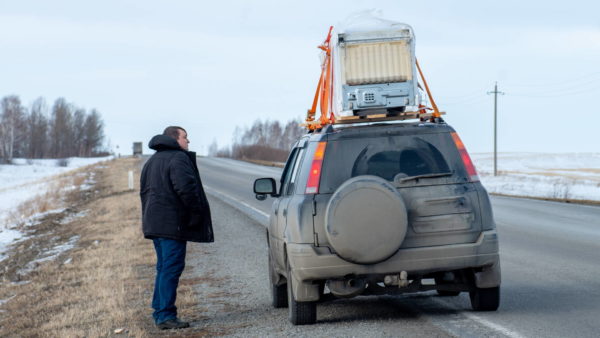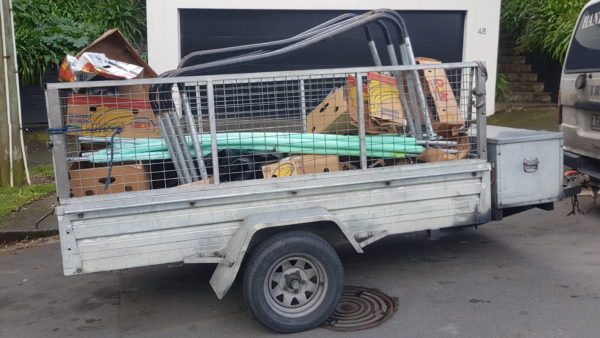Metal roof racks provide very little friction to items loaded on them. If you are using a standard roof rack with metal bars as opposed to custom cases or racks locked to the rack, you’ll need to know how to use straps or ropes (preferably ratchet straps) to get the best load security.
Can your roof rack carry the load?
Roof racks have a rating, which is the maximum load they can carry. If the rack attaches to roof rails on your vehicle, you’ll need to check that rating, too. For example, if your roof rack will take 100kg, but your roof rails only take 80kg, then the maximum load you can carry is 80kg minus the weight of your roof rack. Always look to the lowest rated component.
How will you secure the load?
There’s very little reason to use ropes any more – they are affected by the weather, easily cut, can damage the load and you need to know knots. It’s better to use straps. Ratchet straps are best, but buckle straps are slightly more convenient. They are broader so they spread the load restraint force over a wider area. They’re also much quicker to do up and undo.

Don’t ever use bungee cords for anything other than fastening down a tarpaulin or holding items together which are then restrained with a strap.
Weather protection
Use a tarpaulin to protect both the load and the straps from damage from wind, rain, dirt and sun. The tarpaulin will make the load more aerodynamic; make sure you fasten it securely and close up any gaps.
Wind resistance
Avoid loading flat sheets with the leading edge forwards of the top of the windscreen otherwise wind pressure deflected from the windscreen will try to lift the roof rack off the roof. If you have to do this, keep your speed down and tie a couple of straps lengthways on the rack.
Load smaller items at the front of the rack to help with aerodynamics.
Strapping the load
For flat loads, strap lengthways as well as widthways. Put something else on top of the load to increase the clamping angle of the straps.
For all loads that aren’t blocked up against something else, you need a minimum of two straps and it’s preferably to have one strap at least every 1.5m.
Roll the end of your straps and tie them off, or put the ends inside your vehicle (open your door, put the end of the strap inside, then close the door). Straps that flap around will fray very quickly.
Centre of gravity
Load the heavier items at the bottom of the roof rack and keep them in the middle of the vehicle. The higher the centre of gravity, the more your car will lean in the corners.
Checking the load
Once you’ve tightened your final strap, do a final check of each strap. If you go over bumpy ground, stop and check the load. When you stop for fuel, check the load. If you have a break, check the load – you don’t want to lose things off your roof rack because they can end up hitting a motorcyclist or causing another road user to swerve and have a crash. Plus, you’ll get a fixed penalty notice and the opportunity to transfer the government some of your hard-earned cash.

Note that you can be fined for an insecure load even if the load hasn’t fallen off yet!
Is a roof rack the most suitable option?
If loads are very heavy or difficult to restrain, are they better in the boot or in a trailer? Heavy loads are best carried lower down. Difficult loads may be better carried in a cage trailer.

Slippery loads
Ladders and pipes have very little friction and contact with the rack. Ratchet straps are best for these. Group pipes in threes and tape them together before securing them; pipes should form a triangle formation as trying to secure them flat to the rack will mean the middle one can come loose.

Remove the rack when not in use
Roof racks make your fuel economy worse. This is why it’s best to carry items in the vehicle if possible. When you’ve finished with the roof rack, take it off your vehicle so you’re not carrying around that unnecessary weight and you don’t have the aerodynamic penalty.
Where can you learn how to secure loads to your car?
This online light vehicle load security course will give you the knowledge you need to carry loads in or on a pickup truck, trailer, roof rack, van or car.
